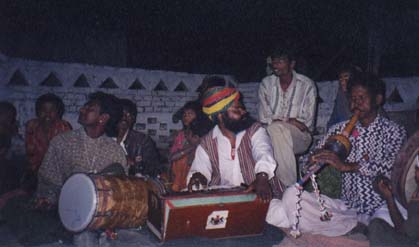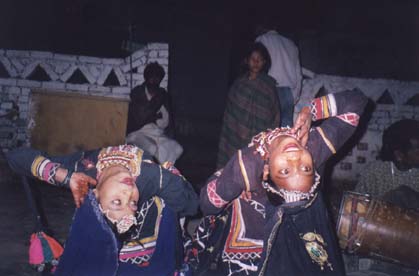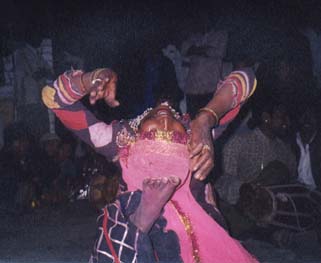|
Reunion, Part 1 The music of the Saperas plays itself over and over in my head. I dig out the phone number Jason gave me back in Mt. Abu, and call it. A man answers; he seems hesitant, but we agree on a time to meet and he gives me his address, saying he'll set everything up with Ramudi. I set off with Ginny and Alyse to meet the Saperas once again. The address I have is of a travel agency. A man there calls Ramudi and she comes to collect us. Fate has dealt a kind hand, reuniting us. As we walk towards her house, she speaks of a falling out with the man we just called. Apparently he used to manage her group, but now Ramudi speaks of him as untrustworthy. She's promoting herself now. We come to a very poor neighborhood, with rundown shacks that struggle to keep out the elements criss-crossed by muddy paths. This is Kalakar Colony, the artists' enclave in Jaipur, home to musicians and puppeteers. For all they contribute to society, they struggle to eke out a living. Ramudi's house is a cozy collection of cement rooms with a dirt garden surrounded by a geometric white brick fence. She lives there with brothers and sisters, sons and daughters, relatives of a very extended family.
Ramudi's
in the back, with green stripes down her dress. We are ushered into her home. Two girls put on dresses, beads, and ankle bells like those Ramudi wore in Mt. Abu. Gulab Nath and Sitaram are out of town, but there are plenty of musicians in the neighborhood. Soon a man with a pungi and another with a dholak arrive.
The
dholak player is on the left, and the pungi player is on the right. Click here to hear the snake-charming sounds of the pungi player and the dholak player. If you listen carefully, you can hear the ankle bells of the Sapera dancers; they sound like a tambourine on this track. A curious crowd gathers. The pungi begins its reedy drone, bells rattle, the dholak joins in. The two girls dance with the music.
They
must be eight or ten, but they move with the same grace as Ramudi;
Another girl dancing the cobra dance.
For another song, a woman balances a large, bright red bowl on a ring of cloth on her head. Smaller and smaller bowls are added, seven in total that stretch nearly six feet above her head. They look precariously balanced, yet she spins around as she dances, bending forwards and backwards. |





